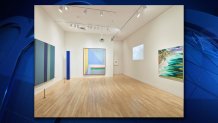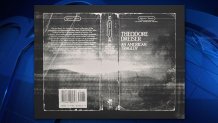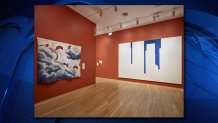The beauty and the complexity of the American landscape is the focus of the Dallas Museum of Art's contemporary art exhibition, "America Will Be!: Surveying the Contemporary Landscape," now on view through Oct. 6.
The title of the exhibition is inspired by Langston Hughes' 1935 poem, "Let America Be America Again." Hughes imagines a future where the American dream becomes a reality for everyone, regardless of race, class or heritage. Curated by Anna Katherine Brodbeck, the museum's Hoffman Family Senior Curator of Contemporary Art, the exhibition investigates the American dream and culture through its landscape. Fifteen new contemporary acquisitions, many acquired from the Dallas Art Fair, complement several of the museum's postwar masterworks to explore American identity.
The exhibition is organized in six sections: the sea, the road, the horizon, bodyscapes, accumulation and cultivation and the home. Some of the works are literal representations of the themes; others are not. "I was interested in reflecting back in the tradition of the American landscape, but as you see, a lot of works don't look like anything you think about when we think about landscape painting," Brodbeck said.

That surprising concept of landscape is evident in the gallery about the sea. Shara Hughes' painting, "Gusto" is paired with the video "Under Discussion" by Jennifer Allora and Guillermo Calzadilla. Hughes' painting depicts a scenic beach, but the palm trees appear buffeted by the wind, signaling trouble. The video shows a fisherman using a table as a boat to navigate around Vieques Island in Puerto Rico. The United States Navy used the area as a bomb-testing site from 1941 to 2003. After it was de-commissioned, decisions about the site were made behind closed doors, much to the local community's dismay.
The two pieces work together to reflect a community discussion about the environment. "So, you have the lush canvas, the beautiful blue water, a great kind of vacation spot, but you also see the intrusion of the military base and how it has disrupted this more romanticized vision of Puerto Rico," Brodbeck said.
The iconic American road is typified by a familiar scene. Thomas Struth's "Dallas Parking Lot" is a photograph of an elevated parking lot not far from the museum. Dallas patrons will recognize the post office on St. Paul. Mixed in with works celebrating the roads that connect American cities, this piece celebrates something vital to America's car culture. "This is a really beautiful picture of how downtown has developed and how important parking lots, which are maybe not the sexiest part of American culture, how paramount they are to the development of cities, especially cities where they rely on cars," Brodbeck said.
The Texas influence continues in the gallery devoted to works related to the horizon. Fort Worth native Justin Adian's sculptural painting "Levelland" is a modern interpretation of the Texas sky. "For me, this is between painting and sculpture, really looks like a sunset in Texas when you still see blue at the top of the sky and pink towards the bottom," Brodbeck said.

The most disruptive gallery is devoted to bodyscapes, an intersection of the human body and landscapes. TR Ericsson's "American Tragedy" is one of the most personal works in the exhibition. After his mother committed suicide in 2003, the artist began creating works inspired by her mementos. An American Tragedy was one of her favorite books and she was cremated with a copy of the book. In creating this silkscreen of book's cover, Ericsson used some of his mother's funerary ash. "The background of the cover has the quintessential landscape, but if you read the text, it is very clear that the American dream has failed a lot of people," Brodbeck said.
Local
The latest news from around North Texas.
A gallery featuring works related to accumulation and cultivation shows how artist scavenge from the landscape and highlights women's contributions to American culture. Summer Wheat's "Bread Winners" depicts women's role of mining the land and providing sustenance. "It almost looks like a textile, but it is acrylic pushed through mesh," Brodbeck said. "It looks very much like this is commenting on a textile tradition, which is typically women's work."
The exhibition concludes with the concept of home, the built landscape. Prominently featured are one of the great comforts of the American home: quilts. A quilt made of discarded denim and Faith Ringgold's story quilt are displayed with Sanford Biggers' "Sirroco" quilt. The artist learned quilts were used to send messages in the Underground Railroad.

Biggers' work is an American classic re-imagined for a modern culture, translating the aspirations of the Langston Hughes poem to the contemporary world. "He found these antique quilts and covered them in spray paint, so it has an element of urban tagging on it," Brodbeck said. "These are all forms inspired by the urban landscape."
Online: dma.org/AmericaWillBe



